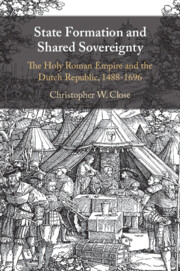Book contents
- State Formation and Shared Sovereignty
- State Formation and Shared Sovereignty
- Copyright page
- Contents
- Maps
- Acknowledgments
- Abbreviations
- Maps
- Introduction
- 1 The Swabian League and the Politics of Alliance (1488–1534)
- 2 Alliances and the Early Reformation (1526–1545)
- 3 Alliances and New Visions for the Empire and the Low Countries (1540–1556)
- 4 Shared Sovereignty and Regional Peace (1552–1567)
- 5 Shared Sovereignty and Multi-confessionality in the Empire and the Low Countries (1566–1609)
- 6 Religious Alliance and the Legacy of Past Leagues (1591–1613)
- 7 Religious Alliance and the Thirty Years’ War (1610–1632)
- 8 Westphalia and Politics of Alliance in the Empire and the Dutch Republic (1631–1696)
- Conclusion
- Bibliography
- Index
1 - The Swabian League and the Politics of Alliance (1488–1534)
Published online by Cambridge University Press: 02 March 2021
- State Formation and Shared Sovereignty
- State Formation and Shared Sovereignty
- Copyright page
- Contents
- Maps
- Acknowledgments
- Abbreviations
- Maps
- Introduction
- 1 The Swabian League and the Politics of Alliance (1488–1534)
- 2 Alliances and the Early Reformation (1526–1545)
- 3 Alliances and New Visions for the Empire and the Low Countries (1540–1556)
- 4 Shared Sovereignty and Regional Peace (1552–1567)
- 5 Shared Sovereignty and Multi-confessionality in the Empire and the Low Countries (1566–1609)
- 6 Religious Alliance and the Legacy of Past Leagues (1591–1613)
- 7 Religious Alliance and the Thirty Years’ War (1610–1632)
- 8 Westphalia and Politics of Alliance in the Empire and the Dutch Republic (1631–1696)
- Conclusion
- Bibliography
- Index
Summary
While many alliances existed in the Empire during the late Middle Ages, the Swabian League became the model par excellence for subsequent leagues. It achieved this standing by offering something unique to all members. It allowed small territories to secure political and military backing from their more powerful neighbors while enabling larger territories to institutionalize spheres of influence. This chapter investigates these dynamics by analyzing the advantages and disadvantages of leagues as tools for military action. The Swabian League fielded one of the most effective fighting forces the Empire had ever seen. Its 1499, 1504, 1519, 1523, and 1525 campaigns established it as a force in imperial politics. They also pushed its members and other Estates to develop in ways that produced later alliances. Ultimately, the League’s operation promoted a vision of the Empire based on collaboration between its territories and the imperial crown that broke down during the early Reformation. Despite its collapse in the early 1530s, the ideal of the Swabian League lived on as the standard to which later alliances aspired. Instead of being rendered redundant, the League’s legacy helped ensure that the politics of alliance remained an essential political strategy long after the League itself disappeared.
- Type
- Chapter
- Information
- State Formation and Shared SovereigntyThe Holy Roman Empire and the Dutch Republic, 1488–1690, pp. 24 - 55Publisher: Cambridge University PressPrint publication year: 2021

